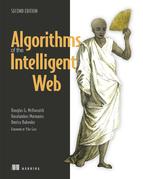Table of Contents
Chapter 1. Building applications for the intelligent web
1.1. An intelligent algorithm in action: Google Now
1.2. The intelligent-algorithm lifecycle
1.3. Further examples of intelligent algorithms
1.4. Things that intelligent applications are not
1.4.1. Intelligent algorithms are not all-purpose thinking machines
1.4.2. Intelligent algorithms are not a drop-in replacement for humans
1.4.3. Intelligent algorithms are not discovered by accident
1.5. Classes of intelligent algorithm
1.6. Evaluating the performance of intelligent algorithms
1.7. Important notes about intelligent algorithms
1.7.1. Your data is not reliable
1.7.2. Inference does not happen instantaneously
1.7.4. Different algorithms have different scaling characteristics
1.7.5. Everything is not a nail!
1.7.7. Training time can be variable
1.7.8. Generalization is the goal
1.7.9. Human intuition is problematic
1.7.10. Think about engineering new features
Chapter 2. Extracting structure from data: clustering and transforming your data
2.1. Data, structure, bias, and noise
2.2. The curse of dimensionality
2.4. The Gaussian mixture model
2.4.1. What is the Gaussian distribution?
2.4.2. Expectation maximization and the Gaussian distribution
2.4.3. The Gaussian mixture model
2.4.4. An example of learning using a Gaussian mixture model
2.5. The relationship between k-means and GMM
2.6. Transforming the data axis
2.6.1. Eigenvectors and eigenvalues
Chapter 3. Recommending relevant content
3.1. Setting the scene: an online movie store
3.3. How do recommendation engines work?
3.4. User-based collaborative filtering
3.5. Model-based recommendation using singular value decomposition
3.5.1. Singular value decomposition
3.5.2. Recommendation using SVD: choosing movies for a given user
3.5.3. Recommendation using SVD: choosing users for a given movie
Chapter 4. Classification: placing things where they belong
4.1. The need for classification
4.2. An overview of classifiers
4.2.1. Structural classification algorithms
4.3. Fraud detection with logistic regression
4.3.1. A linear-regression primer
4.4. Are your results credible?
Chapter 5. Case study: click prediction for online advertising
5.4. What is a decisioning engine?
5.4.1. Information about the user
5.4.2. Information about the placement
5.4.5. Decisioning engine model
5.5. Click prediction with Vowpal Wabbit
5.6. Complexities of building a decisioning engine
Chapter 6. Deep learning and neural networks
6.1. An intuitive approach to deep learning
6.3.2. Training a perceptron in scikit-learn
6.3.3. A geometric interpretation of the perceptron for two inputs
6.4.1. Training using backpropagation
6.5. Going deeper: from multilayer neural networks to deep learning
6.5.1. Restricted Boltzmann Machines
Chapter 7. Making the right choice
7.3. Bayesian bandits in the wild
7.4. A/B vs. the Bayesian bandit
7.5. Extensions to multi-armed bandits
Chapter 8. The future of the intelligent web
8.1. Future applications of the intelligent web
8.1.3. The self-driving vehicle
A motivating example: showing ads online
Data collection: a naïve approach
Managing data collection at scale
Evaluating Kafka: data collection at scale
